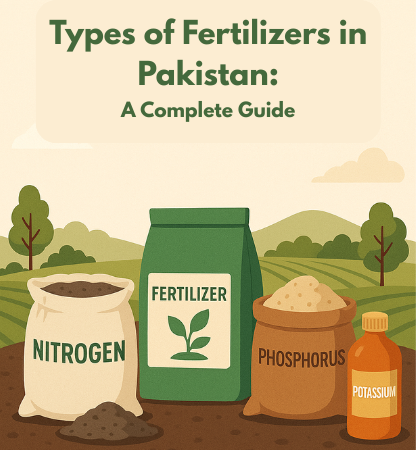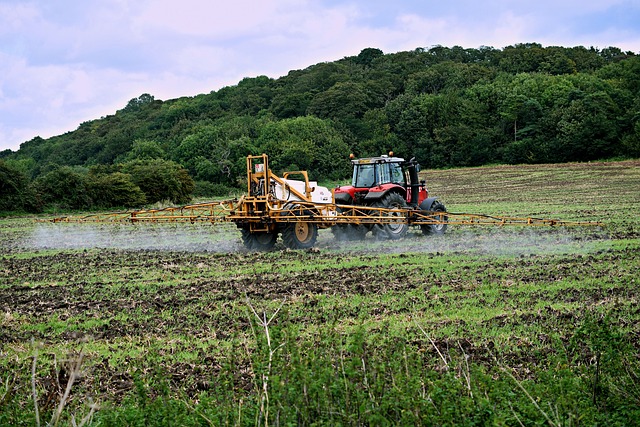
Fertilizers play a crucial role in agriculture, especially in a country like Pakistan where farming supports a large part of the economy and livelihood. From boosting crop yield to improving soil health, fertilizers are essential. However, with so many types available, it’s important to understand the different types of fertilizers used in Pakistan, their applications, and how they affect plant growth.
Table of Contents
ToggleWhat Are Fertilizers?
Fertilizers are substances added to soil or plants to supply essential nutrients that support healthy growth and high yields. These nutrients include nitrogen (N), phosphorus (P), and potassium (K), which are the three main components of most fertilizers. In Urdu, fertilizers are called “khad” (کھاد). Understanding the types of fertilizers is key to applying the right one at the right time for optimal plant health.
Why Are Fertilizers Necessary for Plants?
Not all soils in Pakistan are naturally fertile. Many lack vital nutrients due to overuse, erosion, or poor organic content. Fertilizers replenish these nutrients, enabling plants to grow faster, stronger, and healthier. They help increase agricultural productivity and food supply, which is especially important in regions where soil fertility is low.
Some soils, particularly in Punjab and Sindh, are intensively farmed and need frequent fertilization. Fertilizers are also vital in Balochistan and parts of KPK, where naturally poor soils benefit greatly from nutrient enrichment.
If organic gardening is your goal, discover some excellent options in Organic Fertilizers In Pakistan: 10 Natural Options For Better Growth.
Main Types of Fertilizers Used in Pakistan
There are many types of fertilizers, but they can be broadly categorized into two main groups:
Organic Fertilizers
Organic fertilizers are made from natural sources like animal manure, compost, bone meal, and plant residues. They release nutrients slowly and improve soil structure over time. Examples include:
- Cow dung (Gobar ki khaad)
- Poultry manure
- Compost
- Bone meal
- Green manure
Advantages:
- Improve soil health in the long term
- Environmentally friendly
- Reduce the need for synthetic inputs
Disadvantages:
- Nutrient content is not as concentrated as chemical fertilizers
- Nutrients are released slowly
For an even deeper understanding of eco-friendly choices, explore Organic Fertilizers in Pakistan: What You Need to Know.

Chemical (Inorganic or Synthetic) Fertilizers
These are man-made fertilizers formulated with specific nutrient combinations. They provide quick nutrient availability and are widely used in commercial agriculture.
Major types of chemical fertilizers used in Pakistan include:
- Nitrogenous Fertilizers: Urea is the most common type and provides nitrogen to plants, which is essential for leaf and stem growth.
- Phosphatic Fertilizers: Like Single Super Phosphate (SSP) and Di-Ammonium Phosphate (DAP), they support root development and flowering.
- Potassic Fertilizers: Such as Muriate of Potash (MOP), which enhances drought resistance and overall plant strength.
- NPK Fertilizers: These contain all three primary nutrients (Nitrogen, Phosphorus, and Potassium) in balanced proportions.
Advantages:
- Fast-acting and effective
- Easy to measure and apply
- Tailored formulations available
Disadvantages:
- Can degrade soil quality over time
- Overuse leads to pollution and health concerns
Want to apply your knowledge practically? Here’s a great place to start — Complete Guide to Growing Vegetables at Home in Pakistan.

Different Types of Fertilizers Based on Use
In Pakistani agriculture, fertilizers are used according to crop type, soil condition, and season. Here are the different types of fertilizers based on their applications:
Straight Fertilizers
These supply only one primary nutrient. Example: Urea (Nitrogen only).
Complex Fertilizers
These contain two or more nutrients. Example: DAP (Nitrogen and Phosphorus).
Mixed Fertilizers
Custom-made by blending different straight or complex fertilizers.
Slow-Release Fertilizers
These release nutrients gradually, reducing the risk of over-fertilization.
Liquid Fertilizers
Used in drip irrigation and foliar spraying, they are fast-absorbing.
What Are the 3 Main Types of Fertilizers?
The three main types of fertilizers in terms of nutrient supply are:
- Nitrogenous Fertilizers – For leafy growth
- Phosphatic Fertilizers – For strong roots
- Potassic Fertilizers – For overall strength and resistance
These are the core elements in almost all fertilizers and are critical for plant development.
How Do Different Types of Fertilizers Affect Plant Growth?
Different fertilizers affect different parts of the plant:
- Nitrogen promotes leafy growth.
- Phosphorus encourages root and flower development.
- Potassium improves disease resistance and fruit quality.
Using the right combination ensures balanced plant development and better yields.
What Types of Fertilizers Are Used in Agriculture in Pakistan?
In Pakistan, the most widely used fertilizers are:
- Urea (Nitrogenous)
- DAP (Phosphatic)
- MOP (Potassic)
- NPK Blends (Complete nutrients)
- Organic Manure (For soil improvement)
These are used in crops like wheat, rice, sugarcane, cotton, and vegetables. Farmers may choose fertilizers based on crop cycle, weather, and region-specific needs.
Fertilizers are the backbone of modern agriculture in Pakistan. From improving crop yield to restoring soil fertility, different types of fertilizers serve various purposes. Understanding what fertilizers are, why they are necessary, and how different types affect plant growth helps farmers and gardeners make informed decisions. Whether you’re choosing between chemical or organic fertilizers or trying to understand the types of fertilizers used in agriculture, having this knowledge can lead to better, greener results.
